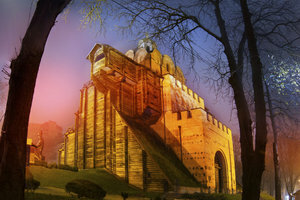Modest Mussorgsky's "Pictures at an Exhibition"
"Pictures at an Exhibition" is the title of one of the most famous compositions by Modest Mussorgsky (1839-1881). At the same time, this work is one of the most famous programmatic pieces of the 19th Century. It is a musical setting of some pictures by the artist Viktor Hartmann, with whom Mussorgsky was friends.

On the genesis of the "Pictures at an Exhibition"
- The piano cycle "Pictures at an Exhibition" was created in 1874 and thus belongs to the composer's late work. Decisive for the composition were ten pictures by the architect Viktor Hartmann (1834-1873).
- When Mussorgsky met Hartmann in 1870, he was already a member of the "Mighty Heap". This was the specially chosen, ironic name of a group of five Russian composers. In addition to Mussorgsky, it also included Nikolai Rimsky-Korsakov, César Cui, Alexander Borodin and Mili Balakirew.
- Mussorgsky's friend and art critic Vladimir Stassow was responsible for the acquaintance of Mussorgsky and Hartmann. In 1870 this ensured that Hartmann was introduced to the circle of the "Mighty Heap".
- Hartmann, who drew a lot in addition to his work as an architect, pursued goals similar to those of the five composers. While they tried to incorporate folk elements of Russian music into their compositions, he used Russian motifs in his pictures. This is believed to be one of the reasons he and Mussorgsky soon became close friends.
- When Hartmann died in 1873 at the age of 39, Mussorgsky decided to put a musical memorial to his friend. Inspired by an exhibition of Hartmann's pictures, he wrote a setting for ten selected paintings.
- The pictures of the "Great Gate of Kiev" and the "Hut of Baba Yaga" are among the most famous settings of the piano cycle. His composition was completed in 1874. It is dedicated to Vladimir Stasov. He had made a significant contribution to the decision to compose the piece.
Have you ever wondered whether music has a statement that goes beyond purely ...
Content of the pictures and musical implementation
- Mussorgsky is not satisfied with setting the ten pictures to music. The individual pieces only become a cycle through the constantly recurring "promenade". This is a short piece that functions as both a prelude and an interlude.
- The "Promenade" has the function of relating the individual images to one another. A person appears before the listener's inner eye, walking past the images one after the other. Sometimes she lingers in front of a picture, sometimes she lapses into thoughtfulness, as is customary when visiting an exhibition.
- The musical "Promenade" becomes something special on the one hand because of its recognition value. It is a catchy melody that consists mainly of small intervals and tone steps and contains Russian folk song material.
- While the first Promenade is in major and played at a brisk tempo, one of its later counterparts sounds much more melancholy due to the minor coloring and the slower tempo. The listener notices that the pictures do not leave the exhibition visitor uninvolved.
- In every picture, Mussorgsky tries to find a characteristic timbre and mood. Many settings meet the requirements of programmatic music insofar as they are implemented very onomatopoeically. The picture of the "hut of the Baba Yaga" is particularly impressive. Here the witch's ride on Walpurgis Night is portrayed in a highly characteristic way in all of its powerful sounds.
- The music to "Bydlo", an old cart pulled by oxen, is less onomatopoeic, but just as pictorial. The music rolls on as if from a great distance, like the steadily approaching cart. As in many other pictures, Mussorgsky strives for Russian melodies that are as unique as they are catchy in their harmony and melody.
- The climax of the cycle is the "Great Gate of Kiev". This piece is of monumental character and lets the size and splendor of the building become clear to the listener's inner eye.
- Due to its variety of sounds and the dazzling musical colors, the "Great Gate of Kiev" appears less pianistic than orchestral. Against this background, it is hardly surprising that the "Pictures at an Exhibition" were later also instrumented for orchestra.
Ravel's arrangement for orchestra
- The "Pictures at an Exhibition" had resounding success not only as a piano piece and as a programmatic composition. They have been used several times as the basis for an orchestral arrangement.
- The most famous arrangement is by Maurice Ravel. It premiered in 1922 and is still played frequently today.
- Since Ravel admired Mussorgsky's composition, he endeavored to find a supportive but not unnecessarily changing one interpretation. In contrast to the piano, it was able to express all tonal facets using different instruments. In this way, an even greater degree of imagery was created.
- In the image of the rich and the poor Jew, consciously used instruments serve the characterization of the two figures. The rich Jew is described by massive strings and woodwinds. The strangely thin sound of the stuffed trumpet used for the poor Jew, on the other hand, looks like a caricature. In this way Ravel illustrates the interpretation that is already hinted at in the piano version.
- Ravel only deviates from the original in terms of the promenades. He omits the repetition of the first promenade that appears in the middle of the composition. This creates a different interpretation. Mussorgsky focuses on the exhibition visitor wandering from picture to picture and in this way combines art and music. Ravel, on the other hand, focuses entirely on the images and their content.
If you have never heard the "Pictures at an Exhibition", it is advisable to look at the original version first. But if you are not yet familiar with the genre of program music, let yourself be impressed by the sonic effect of the orchestral arrangement. Both versions are highly recommended in terms of their similarity as well as their differences.
How helpful do you find this article?


